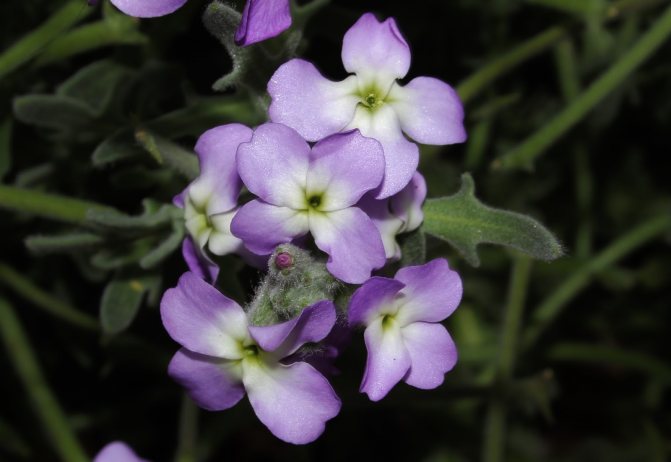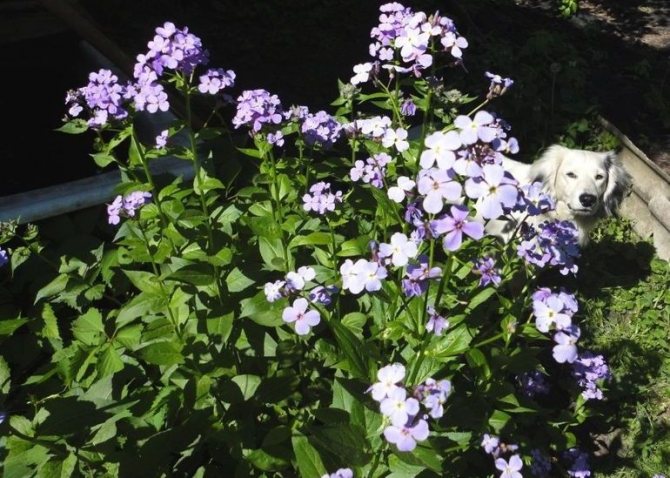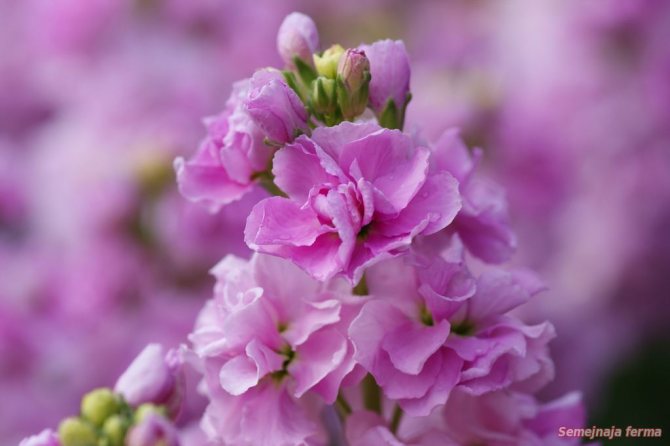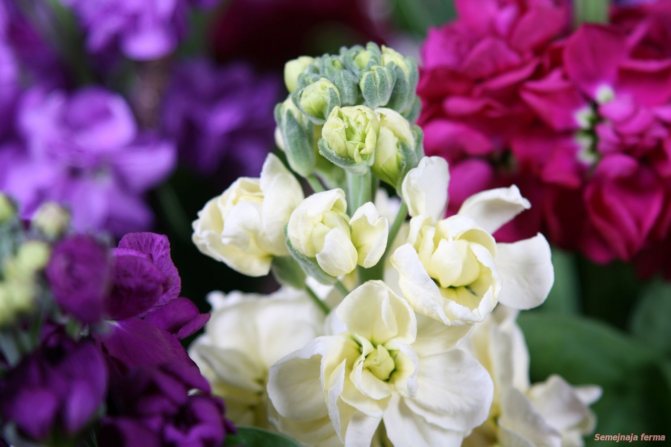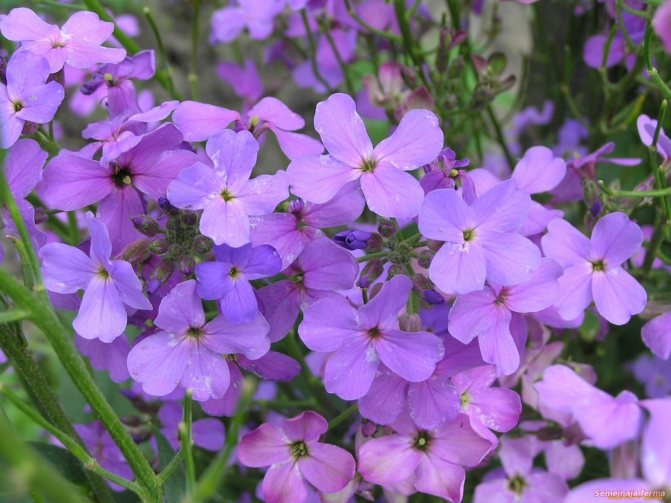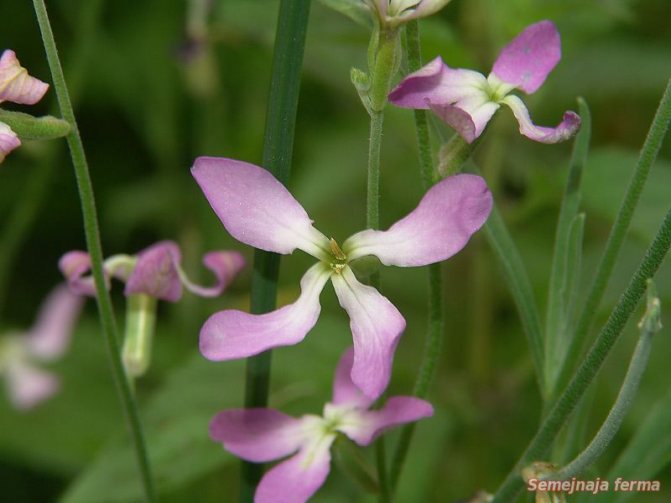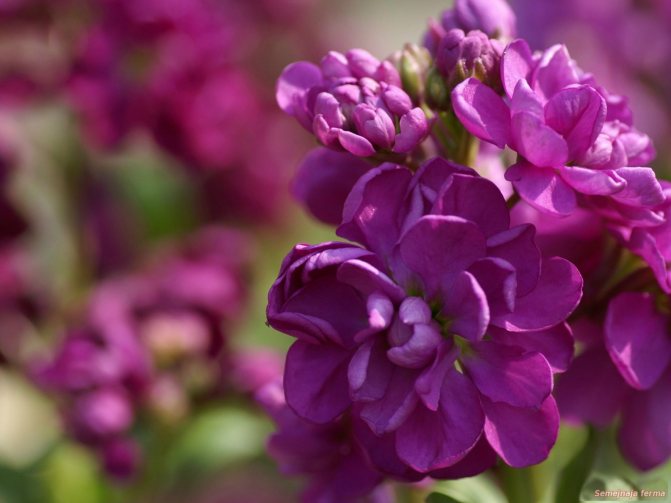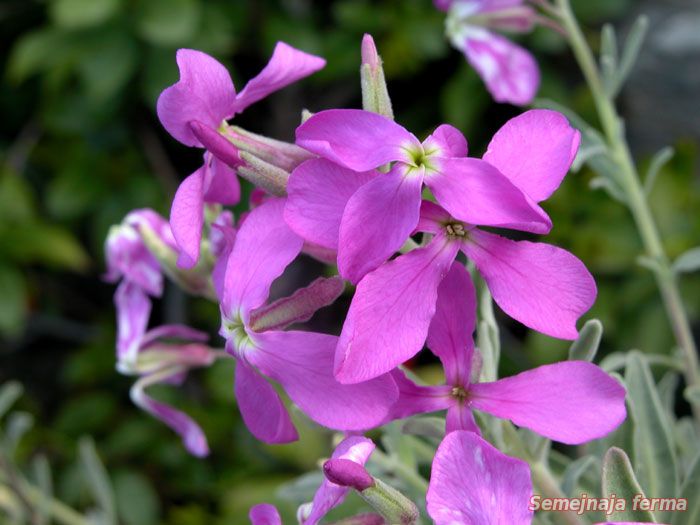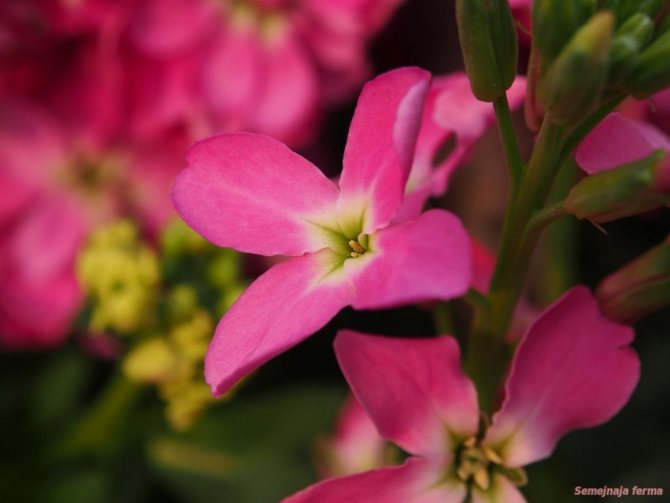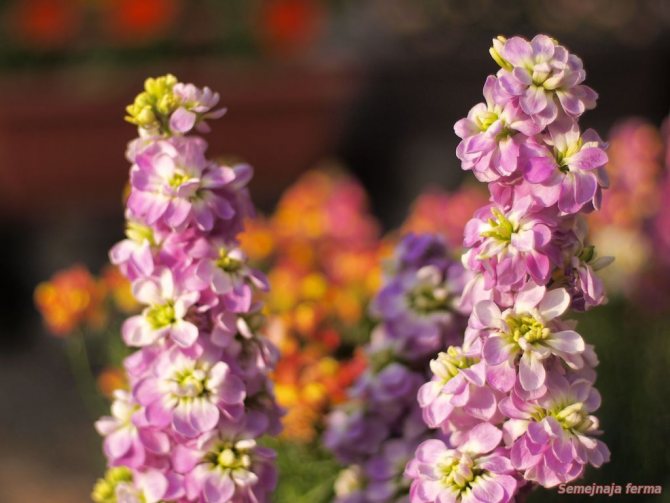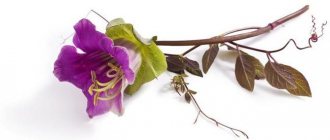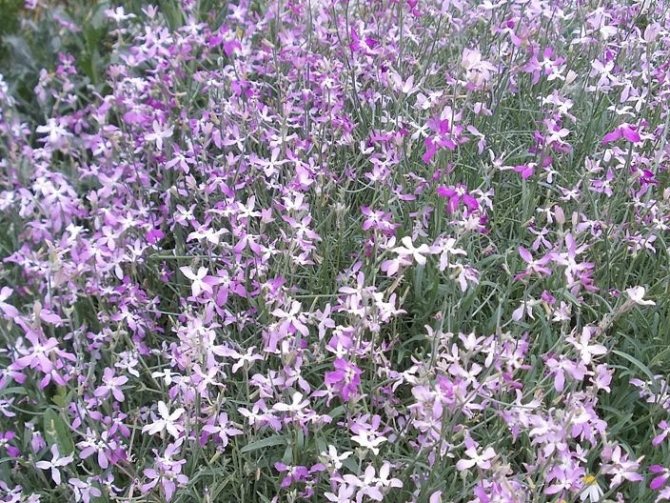
Every gardener knows that, in general, plants for a backyard are selected for their external qualities. However, there are exceptions, because plants can not only delight the eye with their beautiful flowers and green foliage, but also other qualities, for example, it can be useful medicinal herbs or those flowers, the smell of which literally makes your head spin. This is exactly what the night violet is, a flower whose name is soft and pleasant to the ear - mattiola. It is planted in gardens and flower beds not because of its decorative and attractive appearance, but because of the amazing smell that it spreads around itself during flowering.
Hesperis - night violet for a beautiful garden


If a person unfamiliar with the plant looks at the hesperis, obeying the first impulse, he will certainly compare the flower with phlox. Plants form the same dense clumps with tall erect stems, decorated with large lilac, pink or white inflorescences. But the simple corolla of phlox combines five petals, and the hesperis, or night violet, as in the photo, has only four of them, which fully corresponds to the characteristics of plants from the cruciferous family.
In Russia, hesperis is known among gardeners under the name nocturnal or night violet and, as in the photo, varieties of this culture can reveal flowers of white and lilac hues.
The species that came from Europe gained popularity in our country two centuries ago, and in France and the Mediterranean countries, hesperis became famous as an ornamental and medicinal plant in the Middle Ages.
Group plantings of a plant are especially beautiful, while growing violets does not require special skills and even beginners in floriculture can do it. Unfortunately, recently summer residents have lost interest in this culture, which once created a unique atmosphere in the landscape parks of Russian estates and country estates until the beginning of the 20th century.
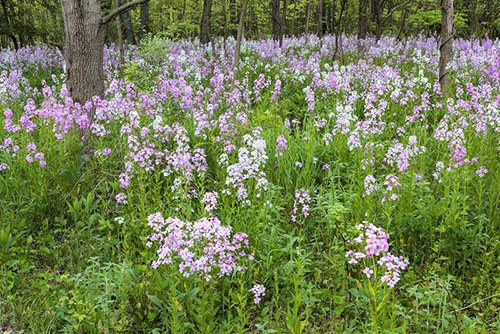

Called nocturnal, night violet or hesperis flower, it unites about 30 related subspecies, some of which have found a place in flower beds and parks. Some representatives of the species grow in Asia Minor and the Caucasus. Moreover, under favorable conditions, hesperis is a perennial herb, found in the wild almost everywhere, from roadsides to forest edges and shores of water bodies.
In culture, the night violet is grown as a biennial, which allows you to achieve the most lush and even flowering of plants.


The stems of hesperis, covered with simple lanceolate leaves, reach a height of 90 cm. The foliage is pubescent with small sparse hairs, attached to the shoots on short, strong petioles. The lower to the ground, the larger the size of the leaf plates, while the largest leaves can exceed 12 cm in length and 4 cm in width.
The inflorescences are quite dense, in the form of a brush or a cap. Flowers of all varieties of violets, as in the photo, open from the periphery to the center. In some cases, the length of the brush reaches 20-30 cm. The flowers themselves are small, symmetrical. The diameter of the corolla is from 1 to 2 cm.
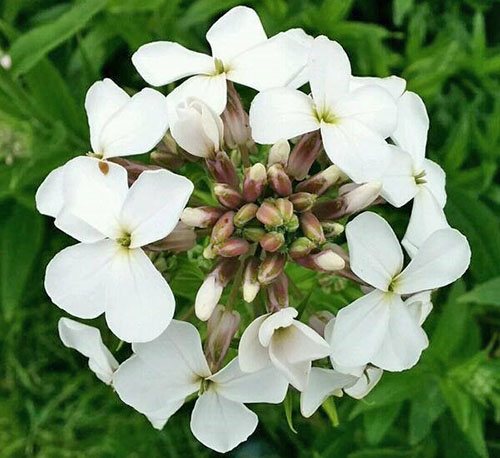

The first buds open in May, and then hesperis blooms almost without interruption until mid-July.In place of the flowers, narrow, oblong pods appear, in which small brown or brown seeds ripen. If you do not cut the peduncles, the ripening seeds spill out and are able to give young shoots the next year.
Despite the opening of the corolla at night and the fragrance of the flowers of the night violet, it is a light-loving plant. But the direct rays of the sun are harmful to hesperis, it is much better to plant branches in partial shade.
How to properly care for violets so that the evening party pleases with flowering and heady aroma? The plant needs light, drained soil to provide the crop with good nutrition. The best flowering is observed on slightly alkaline or neutral soil. During the period of growth and a set of flowers, night violets are provided with good watering, but they do not forget that moisture stagnation does not affect the plant in the best way. But even in the absence of water, there is no need to wait for abundant flowering.


And yet, the cultivation of hesperis is very affordable and not burdensome. For tall varieties of violets, as in the photo, they provide support. And for re-flowering, you just need to cut off the fading flower stalks that take away the forces from plants in a timely manner.
The cultivation of violets is akin to the agricultural technology of other biennials. Plants are propagated by seeds, which are sown for seedlings at home, and then transplanted into the ground. It is also possible to sow in film greenhouses right on the site, this will allow the seedlings to take root faster and more painlessly.
Seedlings appear in 20-30 days, when the soil warms up to 18 degrees. Plants, which have formed three true leaves, dive, and at the end of summer they are planted in a permanent place. By this time, the rosettes are fully formed and will easily tolerate wintering. Between night violet plants it is better to leave an interval of 25-30 cm.
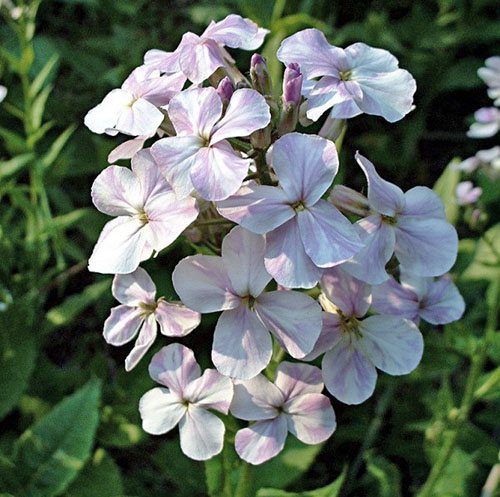

Wintering curtains, if there is not enough snow on the site, are covered with non-woven material or sprinkled with needles.
Site selection and sowing
Despite the “nocturnal” lifestyle, Hesperis and Mattiola love light. However, they feel more comfortable not under direct rays, but under scattered and partial shade.
Fertile, loose, moist soil (neutral or slightly alkaline) is best suited for growing these flowers. In its composition will not be superfluous lime. Before planting plants in open ground, the soil should be dug up and complex fertilizers applied.
Night violets are considered not particularly susceptible to pests and diseases. But they still should not be planted in the places where other crusader (cabbage) cultures grew before.
The main breeding method for these plants is from seed. The most common are biennial soda varieties. Seeds appear in oblong pods in place of faded buds. Therefore, they can reproduce by self-seeding.
In early April, violets can be planted in pots for seedlings, and in late August - early September, planted in open ground, leaving a distance of 10-15 cm between shoots.However, it should be borne in mind that these flowers do not like transplanting very much, so they can be planted immediately into the ground in late May - early June.
Seeds should be sown shallow and not heaped. After planting, spray with water, but do not water, so as not to wash the seeds out of the soil. If sowing is carried out directly into the open ground, then after spraying the soil must be covered with a film, further airing the planting, opening the film from time to time.
The entry of seeds occurs in almost a month. When the shoots form 3 true leaves, the plant dives.
To begin with, it is worth figuring out where it is better to plant seeds of a night violet so that it grows healthy, lush, and also shows a very enviable flowering. If you choose the wrong place, then you can be left without a bright aroma on warm summer evenings, but this option definitely does not suit us.So, it is worth remembering that Matthiola loves sunny areas, well warmed up by our luminary.
It is advisable to make sure that the night violet, the care and cultivation of which we are now discussing, was planted in a flower bed, close to gazebos, benches and similar places where you can relax in nature, enjoying its incomparable smell. Some gardeners believe that as well as cineraria and rejuvenation, matiola pink night violet will look great as a decoration for garden borders and mixborders. Just imagine how pleasant it will be to walk along the paths of the garden when there is a real fragrance around you.
Mattiola: how to grow and properly care for violets
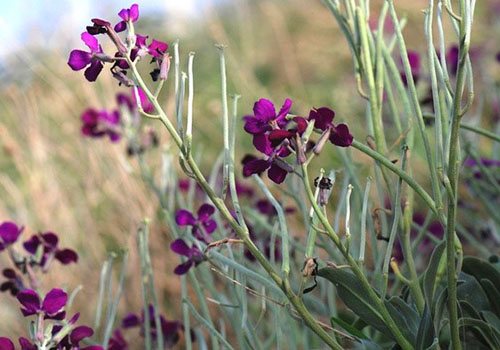

Like nocturnal, mattiola belongs to the cruciferous family and in the evenings it spreads its aroma over the garden. The genus was first discovered and described in the 16th century, and was named after the famous Italian physician and botanist Pietro Mattioli.
Today, botanists have identified about five dozen species of this night violet, in the photo, growing in the Mediterranean region, in the North of Africa and in Asia, in the countries of Central Europe and even in Russia.
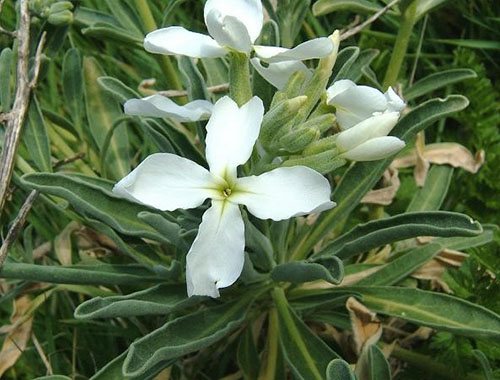

The species includes both annual and perennial crops of various shapes and sizes. Gardeners know mattiola or night violet by a different name - levkoy, which was an unusually popular ornamental plant several decades ago. But it turns out that Levkoi can be found not only in flower beds, but also in the wild.
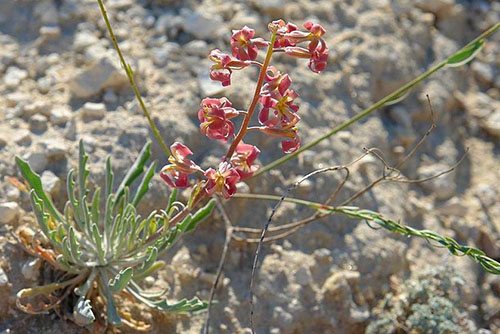

For example, in the Don region, in the Voronezh region and in the environs of Rostov-on-Don, the scent-levkoy grows - a rare perennial plant included in the Red Book. In appearance, this variety of violets, as in the photo, does not give the impression of being decorative. Stems up to 40 cm high are strongly pubescent, a rosette of narrow bluish leaves is noticeable near the ground, and the flowers are very small and dim.
But garden levkoy or gray-haired mattiola from the shores of the Mediterranean Sea, the south of France and the Canary Islands is a real decoration of the garden, especially if the grower is engaged in the cultivation of terry violets.
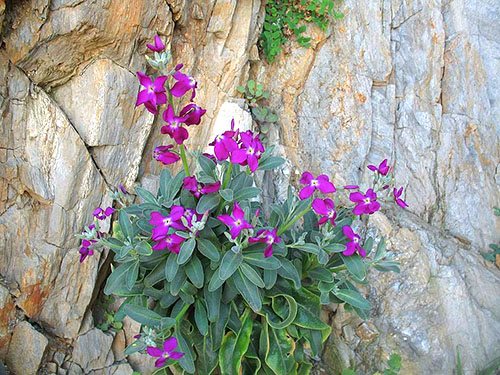

In nature, matthiols are content with very little. They are unpretentious and easy to care for when they enter the garden.
In the middle lane, night violets of this species are cultivated as annual plants, forming stems from 20 to 80 cm in height per season. Usually shoots are densely covered with narrow, dense leaves, which, depending on the variety and type, can be smooth or pubescent, green or silvery-gray.
Terry varieties of violets are especially decorative and attractive for gardeners, as in the photo. Plants such as mattiola with simple flowers smell great, are suitable for cutting and use for landscaping the site.
Mattiola as a separate species
Before dealing with planting and breeding flowers, you need to get the most complete information about it, if you have never encountered this issue before. The smell of flowers during the growing season is most felt in the evening and at night. Only a few varieties are suitable for breeding at home, although more than two dozen species of this plant are known to science.
Need to know
It is worth knowing that planting a night violet is carried out by sowing seeds directly into the open ground, that is, in fact, on a flower bed. It will not take long to suffer, growing seedlings in pots, and then replanting plants in the garden, it is enough to do everything correctly and the flowers will not slow down to bloom.
Most often, experienced summer residents and gardeners recommend not worrying too much about the germination of seeds, they say that a night violet flower, planting and caring for which does not require much effort, grows like weeds. However, it is easy to say to those with relevant experience and practical knowledge.Mattiola or night violet also has a number of other qualities, for example, experienced flower growers especially note its resistance to various temperature conditions.
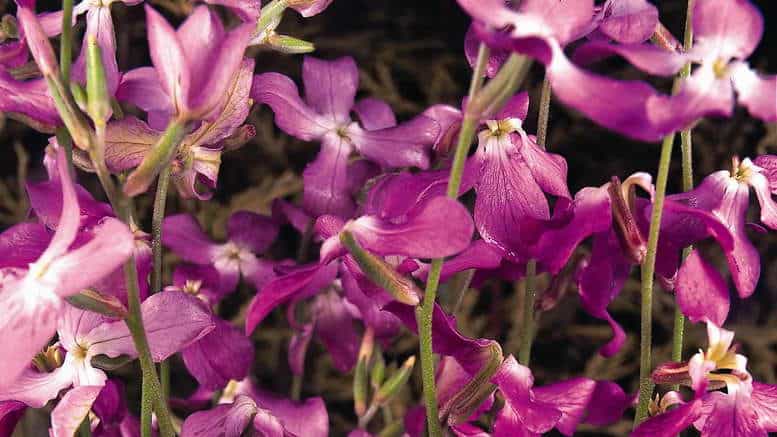

Need to know
Loading ...
The night violet called "mattiola" is a separate species of the same plant, which also includes many unique varieties. These are the same violets from the cruciferous family with lanceolate leaves, an oblong stem, simple or double inflorescences. They are an annual species. The following groups of matthiol are distinguished:
- terry;
- with multi-ton inflorescences (Quedlinburg);
- single-stem for bouquets (Excelsior, Brilliant);
- with a short stem (Erfurt, Pyramidal);
- with large inflorescences (giant), etc.
Directly in horticultural activities, there are two key types:
- Two-horned matthiola. It has a sprawling bushy or erect stem shape 40-50 cm high. The plant branches along the course of development, has linear leaves with large teeth. The flowering period is 1.5 months with self-pollination. The flower has a diameter of 2-3 cm, racemose inflorescence, mauve shade.
- Levkoy gray-haired. The erect stem (single or branched) is 15-80 cm high and is held in place by a taproot. The flowers have the correct shape with pronounced symmetry. They can be both terry (live up to 15 days), and simple monotonous (live no more than 5 days). Some varieties are distinguished by an increased number of petals (up to 100 per bud).
Planting of these species is carried out according to an accelerated scheme. After placing the seeds in the ground, seedlings should be expected on the 9-12th day. Flowering begins after 2-2.5 (early varieties) or 3-3.5 months. Seedling planting after potting is allowed. For this, the seeds are immersed in a thin layer of earth (early April).
DETAILS: Pruning currants in summer after picking berries
For the successful cultivation of pink night violets ("mattiola"), you should prepare the planting soil:
- fertilizer;
- drainage;
- regularity and uniformity of watering (without overdrying and excessive moisture);
- monthly one-time feeding (complex fertilizers).
General description and varieties of night violets
Vechernitsa is a perennial plant, included in the cabbage family, belongs to the dicotyledonous class. In its natural environment, it is distributed in European countries, the states of the Mediterranean strip, in the Caucasus. On the territory of Russia, an ornamental shrub is grown in the central regions and Eastern Siberia.
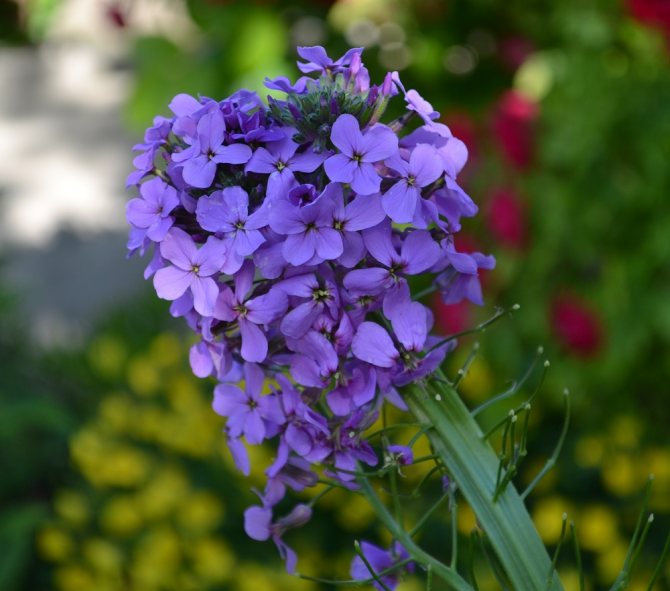

The plant reaches a height of 0.5-1 m. The stems have branches, the surfaces are covered with pile. The leaves are elongated, with a pointed apex, reach 10-12 cm in length, 3-4 cm in width.
In May, small flowers with 4 petals appear on the plant. The buds unfold from the periphery. The diameter of the corollas is 1-2 cm. White or pale lilac buds are combined into rounded inflorescences, the length of the brushes is 25-30 cm. In addition to standard flowers, there are also terry varieties. The aroma of plants is enhanced in the dark. The flowering period, depending on weather conditions, is 30-50 days.
The ornamental shrub bears fruit, forming cylindrical pods (up to 6 cm) with seeds - up to 1.5 thousand pieces per 1 g. In the open field, the seed pods can not be cut off, after ripening the seeds fall into the soil and sprout in spring.
The collected planting material can be used for 2 years. Plants are winter-hardy, do not require insulation. In cultivation, the flower is unpretentious and is a honey plant, helping in the pollination of fruit bushes and trees. In addition to decorative functions, the plant has beneficial characteristics (anti-inflammatory, diuretic) and is used for medicinal purposes. The stems of Matrona's Vespers contain essential oils, flavonoids, etc.
Among the varieties of noctresses for decorating the landscape of sites are popular:
- Mattiola Evening scent;
- Mattiola Starlight;
- Mattiola is gray-haired;
- Mattiola Lilac;
- Two-horned matiola pink, etc.
- Flowers of Mattiola Evening scent has a delicate lilac hue, the buds are connected in voluminous inflorescences. The stems are branched, up to 40-45 cm in height. During the flowering period, the plants exude a delicate aroma. The type is versatile, unpretentious, used to decorate gardens, cottage courtyards, alleys.
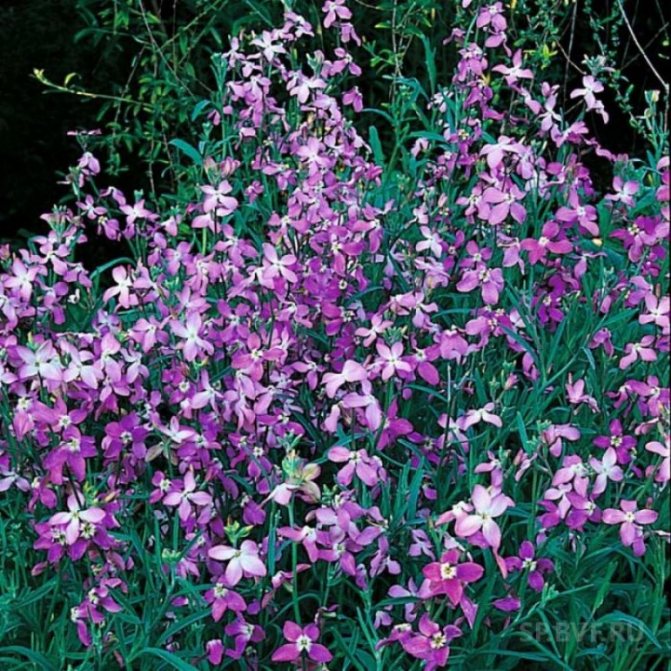

- The variety Mattiola Starlight reaches a height of 50 cm. The buds of the plant are lilac or pale pink. The bush aroma is most intense in the dark. Experts recommend planting a variety of places at the entrance to the building, next to window blocks and gazebos.
- Grade Mattiola gray-haired low (30 cm). Flowers of delicate shades are collected in lush inflorescences. The peculiarity of the variety lies in its special attractiveness in the evening and at night. In the afternoon, the flowers are half-open. Experts recommend planting a plant in the central part of the garden; the species is not used to decorate borders, arbors.
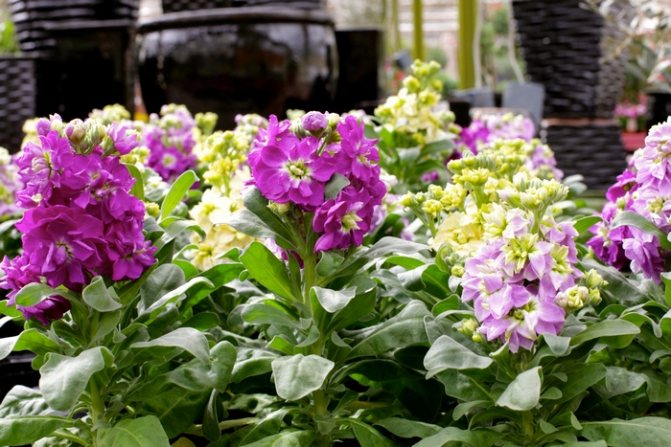

- Variety Mattiola Lilak belongs to tall shrubs (more than 50 cm), branched stems, compact leaves, have large teeth. The flower is intended for areas of the garden with good lighting. Delicate lilac buds are collected in compact inflorescences, exuding a delicate aroma.
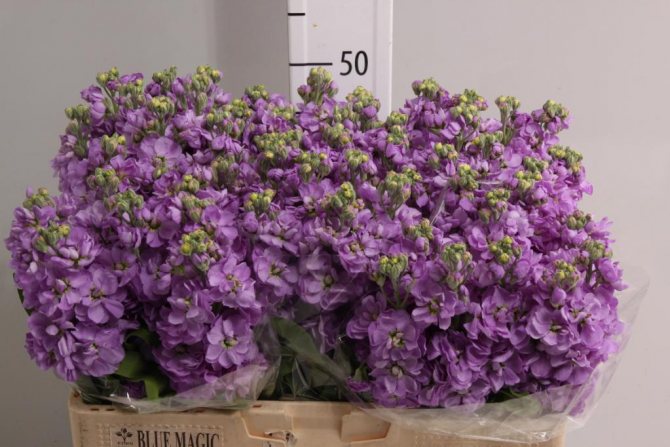

- Two-horned matiola pink - a night violet with spreading branches, erect stems. Plant height is average (40-50 cm). The shrub is an annual, not whimsical to care for. During the flowering period, buds of a delicate lilac bloom, united in inflorescences in the form of elongated brushes.
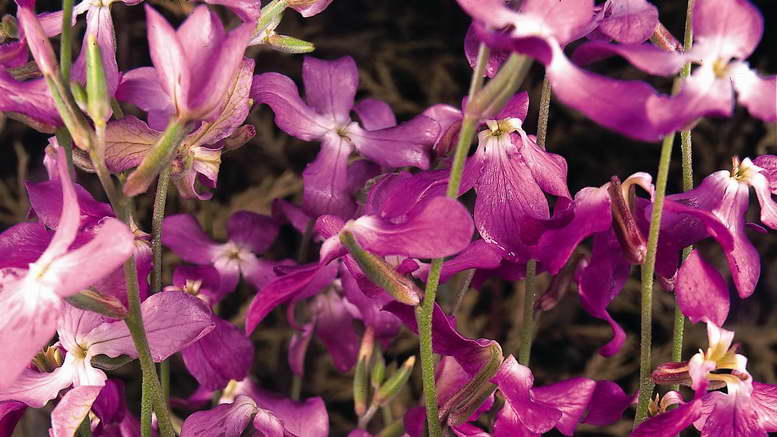

Description of popular varieties of flowers
Matiola two-horned - sprawling, densely branched, herbaceous plant with erect stems. Its height does not exceed 40-50 cm. The green leaves of the “night violet” are linear, elongated, large-toothed. Small, like a Coleus, simple lavender flowers are collected from loose racemose inflorescences.
The most popular varieties of Mattiola bicorno, most often used for planting in the country: Evening aroma and Lilac (purple), Night violet (lavender), Star color (variety mixture with different shades), Sedaya - “Sugar with spices”.
The night violet is a flower from the genus Hesperis (the bright representative is Hesperis Matronalis), a cruciferous family. It is a tall (50-75 cm) perennial. The visual characteristics of the plant are as follows:
- straight stem;
- lanceolate leaves;
- large raceme-like buds of purple or lilac color (flower diameter - from 2 cm).
As already mentioned, at the olfactory level, the night violet is noticeable in the evening and at night, when the inflorescences emit the strongest aroma. Remarkable is the fact that before the rain the smell intensifies and becomes similar to levkoy.
In horticultural activities, the most popular are terry varieties containing a unique variety with white flowers. The plant has about three dozen species, distributed over the territory of the Eastern Mediterranean, Western Siberia, some Asian and Central European regions.
Let's take a closer look at Matthiola. It belongs to the Cabbage family and is native to Europe, Asia and Africa. Levkoy has more than 40 species. It is a herbaceous shrub with erect stems.
Miniature horticultural crops do not exceed a height of 25 cm, the maximum height of Levkoy is 80 cm. Its leaves are latent, toothed, oblong. Flowers can be:
- white;
- blue;
- dark yellow;
- lilac.
They form graceful inflorescences. Night violet blooms for a long time: from early summer to late autumn. Its fruit is presented in the form of a pod filled with small seeds. Levkoy emits a refined aroma. Terry species of this culture are not honey plants.
Hesperis, or night violet, was a favorite flower of the French queen Marie Antoinette and is widely used in landscaping today.
The plant belongs to the Cruciferous family, in appearance it resembles a paniculate phlox. In Russia, hesperis can be found almost throughout the territory. The flower grows along the banks of reservoirs, and on the sides of roads, and on forest edges. It has a branched stem at the top, which is covered with small hairs and looks like a silk one. The leaves on it are alternate, parallel to each other. The leaves are attached to the stem by cuttings.
In the wild, the flowers are lilac in color, but in cultivated varieties there are pale blue and even white flowers. They are not revealed at the same time. First, those that are lower on the stem begin to bloom, and then the buds located closer to the top. They are collected in a loose paniculate inflorescence.
Flowering occurs at the end of May and lasts until the end of August. At the end of flowering, small oblong seed pods remain on the stem. In order to prevent self-seeding, they must be cut off.
Planting and leaving
The plant is easy to plant, grow, care for. The flower, depending on the characteristics of the variety, is planted in the shade or in areas with good illumination. Different degrees of humidity are possible. Optimally diffused illumination of the site, because exposure to direct sunlight negatively affects the shrub during the flowering period.
The soil is preferable neutral, slightly alkaline, medium moisture, supplemented with drainage. Boggy areas with close ground waters are not recommended. Before planting, the soil must be loosened, fed with fertilizers (compost, mineral additives, humus).
The plant needs regular watering once every 7 days. In dry summer seasons, soil moistening is required more often. Watering is carried out in the morning in 2 stages, then the soil must be loosened. It is important to prevent stagnant water. Fertilizing with mineral additives is required for the shrub no more than 2 times in 30 days. Ash is also used to saturate the soil with nutrients.
A tall plant with thin stems and voluminous inflorescences requires the organization of supports, garters to prevent the destruction of the shrub in windy weather and with heavy rainfall.
The plant is frost-resistant. A perennial for the winter period does not require insulation with sufficient snow cover. With a small amount of snowfall in frosty winters, it is necessary to cover the shrub with an awning. At the onset of spring, to prevent damage to the plant, it is required to clear the area from the remnants of wet snow.
Landing features
The night violet is planted in May, when the weather is warm (it is better to choose a cloudy day). Mattiola takes root in a spacious sunny area. She prefers light, draining pova. I do not advise planting a flower in an area where groundwater occurs, the roots may suffer.
Matthiola does not have high requirements for the acidity of the soil, but it is desirable that it be neutral. If the soil in a particular area is poor, fertilizer must be applied. Before planting seedlings, it is necessary to moisten the holes, then slightly compact the soil. Low-growing varieties are placed at a distance of 20 cm, the distance between branching should be 40 cm.
Wild hesperis and matiola adapt to different conditions, and their garden varieties are unpretentious and do not require any special difficult care.
DETAILS: Raspberry bryansk marvel care in the fall
Watering is the most important thing in caring for a night violet. This plant does not tolerate drying out of the soil and stagnant water. Therefore, watering should be regular and moderate. It is best to produce it in the evening in 2 stages, allowing the water to be absorbed after the first watering. Immediately after watering, loosen the soil and remove weeds.
Once every 2 months, a violet can be fertilized using complex mineral fertilizers for flower crops. In addition, wood ash can be used for fertilization, which will not only enrich the soil with the necessary substances, but also make it more alkaline, which will favorably affect the growth and flowering of the plant, especially if the soil was originally acidic.
Matthiola and Hesperis are frost-resistant varieties. Therefore, mature plants do not need additional cover before winter. However, young plants wintering for the first time can be mulched if frosty or little snowy winter is foreshadowed.
Night violet will feel great on the balcony or loggia. Low-growing varieties of mattiola are best suited for growing in such conditions, for example:
- matthiola pink;
- lapis lazuli;
- tango;
- step.
The ideal place for mattiola would be a sufficiently lit balcony that does not face south.
Mattiola seeds are sown for seedlings in March, and at the beginning of summer they are transplanted into pots or wicker baskets and taken out to the balcony. Otherwise, growing on a balcony is no different from growing on a garden plot. The plant also needs regular watering, loosening and complex fertilization.
If the balcony or loggia is glazed, then the plant will be able to overwinter in its place.
Traditionally, hesperis is bred using its own seeds. Landing in open soil is carried out during May-June. You can also use a cold greenhouse. A month after planting, the flowers dive. As the plants develop, they should be planted (August-September), setting a fixed distance of 30-45 cm.
In the process of planting and caring for a plant, it is worth following some recommendations:
- the soil should be loose, slightly alkaline, saturated with humus and with a lime additive;
- an extremely long flowering period is ensured by removing wilted (dried) inflorescences;
- for night violets ("matron's nocturnal" and other species), the same diseases and pests are relevant as for other cruciferous plants (for example, for cabbage);
- waterlogging of the soil is unacceptable (the flower can rot, although it loves moisture);
- uniform distribution of moisture will prevent the attack of earthen fleas.
Popular varieties
Directly Hesperis Matronalis is divided into two most popular types:
- var. nana candidissima with white inflorescences;
- a f. purpurea plena with double purple flowers.
Apart from these types, you can also find the following names:
- nocturnal Siberian;
- nocturnal yellow;
- a scented night violet that is popular as a house flower grown on balconies.
Although it is considered preferable to sow seeds directly into the open ground, there is another method - that is, seedlings that will have to tinker with. However, to each his own, and if you grow tomatoes, cabbage or cucumbers in this way, then mattiola will not be superfluous at all. However, let's do everything in order so that there is no confusion and everything is extremely clear and understandable.
- In the first half of April, you need to prepare the soil, that is, loosen it again, or dig it up, depending on the consistency and texture. However, this should be done only once, otherwise the earth may dry out excessively, which is undesirable, because the night violet loves moisture. Ox in the second half of the month, or at the very beginning of May, mattiola seeds should be sown in even rows in the ground. If you want the plant to delight you with a bright aroma for longer, it is worth sowing a few more rows in two weeks, and you can repeat this until the very end of June, mid-July.
- The second method is seedling, it is more time-consuming and requires some loss of time. First you need to prepare the soil, which consists of three parts of sod land and one part of sand. Having planted seedlings at the beginning of March, after two months you will already get a violent flowering.The seeds are sown in containers, and sprinkled with earth or sand for only half a centimeter, and watering the future seedlings is not required at all until the first thin sprouts appear on the surface.
With the seedling method, the sprouts should show their tops after four days, after which the container must be watered abundantly with clean, settled water. It is worth making sure that the room where Matthiola grows is light and spacious, in which the temperature does not drop below ten to twelve degrees.
Important
In our climatic and weather conditions, the night violet, planting and caring for which is quite simple, blooms violently and fragrant from July to mid, late September, depending on the air temperature, the availability of sunny days and other factors. After the first frost, seeds can be harvested, which are hidden in pods with two horns. Seed germination is fully maintained for at least three years.
Important
Growing
The plant is intended for planting in parks or growing on balconies, in pots. It is necessary to place the flower on the light side of the house, the light should be diffused. In the southern zone of Russia, it is possible to plant Hesperis (evening evening Hesperis) at the dacha in shaded areas.
When planting a night violet in a pot, it is necessary to provide for the stability of volumetric tubs and select fertile soil. Scientifically, it is necessary to provide drainage for the development of the root system and regularly feed.
In the open field
A common method of planting a flower by gardeners is outdoors as an ornamental plant.
When growing seedlings, direct sunlight is prohibited, shaded areas are recommended. The soil is optimally moist, neutral or slightly alkaline. The soil must be loosened regularly by adding lime compounds.
When placing seedlings, areas of the garden where cabbage was grown are not recommended to prevent infection of an ornamental plant with diseases and insects from a vegetable crop.
It is possible to expand the growth by self-sowing from ripe seeds. To prevent overgrowing of the territory and loss of decorative appearance, part of the young shoots must be planted once every 3 years.
Care
Perennial plants thrive best in open areas that are well lit by sunlight. The ideal option for growing at home would be the location on the south-facing balcony.
Terry and simple varieties are planted without damaging the earthen coma on the rhizome. Depending on the type of plant, the distance between the seedlings is maintained. A cloudy day or evening time, when there is no bright sun rays, will be ideal for planting. If the seedlings are located too close to each other, it threatens a black leg infection. Matthiola grows well in fertile, loose soil with neutral acidity. Heavy soil and prolonged stagnation of water are unacceptable.
Two-horned matthiola and other varieties are unpretentious in care. They need active lighting and high-quality drainage system. Watering should be regular, but not too abundant. It is recommended to loosen the soil more often so that a dense earthen crust does not form under the influence of moisture. Weed weeding is of great importance, since levkoi do not tolerate aggressive plants in the vicinity.
Systematic feeding of perennial matthiols is not required. In the spring, it is enough to water the seedlings once with a solution of a complex fertilizer intended for flowering plants. In the presence of fertile soil, even this is not necessary.
Levkoi are especially vulnerable to fungal attack, in particular blackleg and cabbage keel. To prevent infection, it is necessary to properly care for the plants.Matthiola should not grow too close to each other and be over-watered. The most common pests are considered to be white, cruciferous flea and cabbage butterflies. By treating perennial and annual flowers with special insecticides, you can quickly get rid of their negative effects.
Reproduction methods
Breeding lilac and white night violets is performed using:
The decorative flower can propagate in the open field by self-seeding. For the formation of compositions in the park, it is recommended to grow seedlings from seed material. Optimal seeding periods are March-April.
It is necessary to prepare boxes with earth, place seed on the surface and cover with a layer of soil 1.5 cm.Use humus and peat mixed in proportions 1: 1. The top layer is compacted, poured over with water. The boxes must be covered with polyethylene or covering material.
Containers with seedlings are placed in a lighted room with a temperature of at least + 20 ° C. It is necessary to ensure regular watering. The first shoots begin to appear in 15-20 days.
After appearing on shoots from 3 large leaves, the plants can be transplanted into a flower garden. Seedlings are placed at a distance of 25-35 cm. For quick rooting of the sprouts, it is necessary to regularly loosen, water and fertilize the ground. The flowering of the plant begins at 2 years.
Sowing seeds before winter is carried out in the autumn period before frost. When sowing from springtime, the seeds are placed in warm soil.
Cuttings
Some rare varieties are divided by cuttings. Sprouts without peduncles are used, which are cut and placed in containers to a depth of 1-3 cm. To accelerate the formation of the root system, a greenhouse effect is created for the sprouts, covering them with a film and treating them with root roots. It is necessary to regularly ventilate the planting material. The breeding method is popular for terry nocturnal species.
By dividing the bush
For overgrown ornamental plants, the propagation method is by dividing the bush. The roots must be dug up, cut into pieces with a garden knife and spread over the garden. For rooting, plants are placed in the soil at a shallow depth.
Planting time, soil requirements
It should be planted in the ground in early May, seeds begin to germinate by the end of the second week. The most beautiful flowers grow in neutral soil, in extreme cases, slightly alkaline. Acidic soils oppress the plant and you should not expect a good result on them without the use of special measures that lower acidity.
Seat selection
Despite the fact that the inflorescences open in the evening, night violets love sunlight. However, direct sunlight can damage the delicate plant. Therefore, it is necessary to choose a landing site in partial shade. Over the five centuries during which people have planted this flower, a huge number of varieties have been bred that have a color of burgundy, lilac, raspberry and lilac shades.
How to plant - two methods
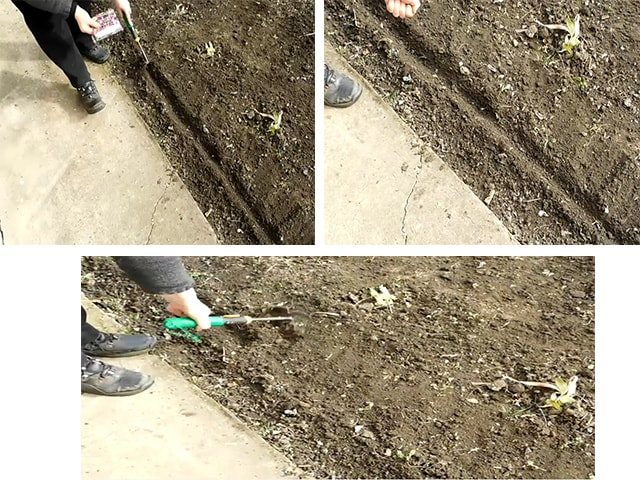

After planting, the night violet does not require any special and cumbersome care. Seedlings and seeds are used for planting, each method is good in its own way. By planting seeds directly into the soil under the film, you get an adapted, strong plant that will not hurt.
The use of night violets in landscape design
An ornamental plant is common in landscape design. The location of the shrub is determined by the characteristics of the territory and the project.
The shrub is planted in groups over a large area. Blooming Mattiola (night violet) loses its decorative effect by the end of the summer season, therefore it is important to supplement the composition with annual late flowering plants.
Flower groups are placed next to artificial lakes to create a recreation area. Flowering bushes are set off by ferns and ornamental grasses.
Lilac and white night violets are combined with different types of ornamental plants. Optimal planting next to nasturtium, petunia.Spicy herbs (sage, basil, thyme, lemon balm) shade elegant flowers. The combination of aromas will create an original flower garden.
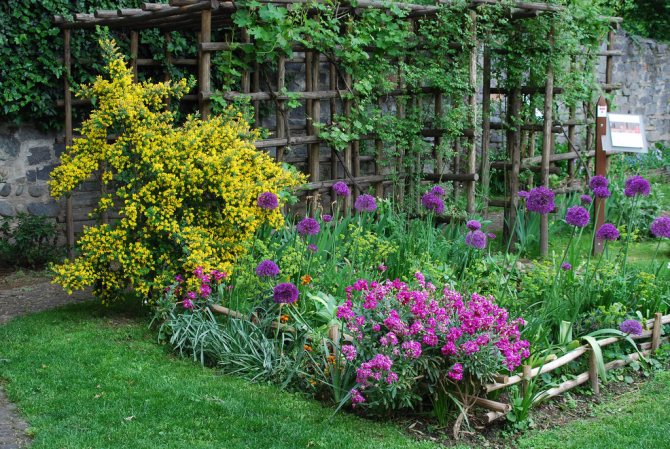

Harmoniously ornamental shrub is combined with yarrow, cornflower, geranium, monarda. Spectacular compositions are created by combining violets with spreading roses of different shades. When planting a night violet-lyubka two-leaved on alpine hills, it is necessary to take into account the drying of the leaves by the end of the summer period. It is required to supplement the composition with late flowering plants.
Placing ornamental bushes along paths, curbs, at the entrance to the house, at benches, gazebos, on flower beds is popular. Light shrub flowers are effectively set off by evergreen cypress, juniper, larch, thuja and other conifers.
Perennials are combined with daffodils, hyacinths, tulips, carnations, lupines, calendula. Effectively combining different shades of violet in one front garden. Low varieties of ornamental plants are suitable for creating compositions in pots, pots on loggias, balconies, verandas.
Every gardener knows that, in general, plants for a backyard are selected for their external qualities. However, there are exceptions, because plants can not only delight the eye with their beautiful flowers and green foliage, but also other qualities, for example, it can be useful medicinal herbs or those flowers, the smell of which literally makes your head spin. This is exactly what the night violet is, a flower whose name is soft and pleasant to the ear - mattiola. It is planted in gardens and flower beds not because of its decorative and attractive appearance, but because of the amazing smell that it spreads around itself during flowering.
Flower varieties
The genus Mattiola has about 50 main varieties. Of these, scientists managed to breed about 600 ornamental plant species. Violets are classified by height:
- high;
- medium;
- dwarf.
According to the structure of flowers, matthiola is divided into simple and terry.
The most popular varieties are mattiola two-horned, gray-haired and fragrant.
Mattiola two-horned
The annual plant has a branched stem that forms a small, 50 cm, round bush. In the period from June to August, the flowering of Mattiola bicorn occurs. The flowers are simple, consist of 4 petals. The color is lilac or pale pink. The plant exudes a rather strong pleasant aroma. The fruits are represented by pods, in which small oblong seeds ripen. Mattiola two-horned is often used by flower growers when creating a variety of landscape design projects.
Mattiola gray
The annual plant is weakly branched. The height of the shoots is 20 - 80 cm. Oval leaves with short pubescence densely cover the stems of Levkoy. Flowers can be either simple or double. At the top of the plant, they gather in dense, attractive inflorescences. Their color is varied, there are white, blue, pink, purple and yellow flowers. The flowering period of this variety of Levkoi lasts from June until the first frost. In the southern regions, mattiola pleases the eye with its lush inflorescences, even in winter. Fruits appear only in varieties with simple flowers, they are represented by flat pods with seeds inside.
Mattiola fragrant
Perennial herb, the height of which reaches 20 - 50 cm. Leaves and shoots are colored dark green, covered with long felt down, which has a silvery shade. Fragrant mattiola blooms in May - June. The racemose inflorescence consists of simple yellowish-brown flowers. The buds open at night and exude a characteristic scent.
Each grower will be able to choose the right varieties for their garden or balcony. White and lilac, purple and yellow, pink and blue inflorescences will be a wonderful decoration for the exterior.
Description of nocturnal violet
The plant is classified as biennial; it begins to bloom in the second year after planting. A representative of the cruciferous family, the inflorescences are collected in a bouquet, and the leaves are in the form of thin lines. There is a slight resemblance to phlox - the same inflorescences with bright flowers. They can reproduce by self-sowing, therefore, it is cramped for them in the flowerbed, and they move to nearby territories.
- Height: hesperis is a herbaceous bush that can grow up to a meter over the summer. Better to plant in a flowerbed as an accent or background.
- Stem: erect, branching towards the top, where several panicle-inflorescences are formed.
- Leaves: oblong, pointed at the ends, dark green, extending down to the inflorescences. Each leaf has a slight pubescence, which gives a slight blue to the plant.
- Flowers: small, oblong four-petal with a yellow stamen. The color scheme is scattered from lilac to white. There are double varieties, but those with smooth flowers are more popular.
- Flowering: the buds begin to open at the end of May, which delight the eye before the arrival of the first frost.
The long flowering period made the night violet a welcome guest on city and park flower beds, private garden plots. You can recognize Hesperis by its bright panicles and a light but persistent fragrance.
Description of the plant
The genus Mattiola (Matthiola) in nature has more than 50 species of annuals and perennials. The most popular in home floriculture are Matthiola bicornis and Matthiola incana.
Gray-haired matthiola, which is also popularly called levkoy, is loved by gardeners for its bright double flowers, collected in large brushes. White, lilac and cherry blossoms are always eye-catching. However, the aroma of levkoy is much weaker than that of night violets, and it is propagated by levkoy mainly by seedlings, which gives summer residents certain troubles.
Matthiola two-horned is much more popular, since its main advantage in cultivation is sowing seeds directly into the ground. These specimens grow up to 50 cm in length, they have long creeping shoots and pubescent leaves. The flowers are simple, pinkish, pale lilac, It is resistant to cold and undemanding to lighting. Even children can be entrusted with caring for her.
To get flowers that will delight the eye, you need to regularly water the seedlings. But it should be remembered that matthiola does not react well to stagnant moisture. Apply water sparingly; to improve photosynthesis, loosen the soil. Mattiola rosea breathes well if there are no weeds near it.
Gorgeous and unpretentious night violet: when to plant and what soil to choose
It is clear that when we have already figured out the preferred places, it's time to talk about the landing itself. Moreover, you need to understand that a night violet, a flower, a photo of which you can examine carefully, does not require an excessive expenditure of time and effort from you, it is so easy to grow and care for, which is preferable for most novice florists. However, even here there are a couple of fairly simple rules that must be followed so that the night violet flowers, the cultivation of which we are just discussing, give abundant and fragrant.
- At no time should mattiola or a night violet, the photo of which is presented in all its glory, sit on those areas of your personal plot where cabbage was previously grown, or other plants from the cruciferous family. The thing is that they infect the ground with a certain fungus, which is not dangerous for other plants, but all your efforts to grow night violets can really be nullified. This tiny invisible enemy fungus is called keela, and it affects only the roots of the plant.
- It is worth thinking about the soil, which can be anything other than sour. Night violet, photos of flowers of which are abundant on the Internet, can not stand overly acidic earth.If you have circumstances that there is no other way, you will have to bring some land from another place, or start reducing the acidity of the soil, which is quite dreary and far from easy.
- Seeds of flowers of a night violet, planting and caring for which does not require much effort, can be collected independently, and this will need to be done in the fall of every year. They can be found on the plant, they are hidden in special pods that need to be removed only after the first frost, and not before.
- The soil for planting matthiola should be prepared in the fall. It must be thoroughly dug up, loosened and fertilized so that everything is ready for the frost.
Variety
In total, there are more than 30 species of noctuples in the wild. In the twentieth century, the plant was cultivated and new varieties were bred to the delight of gardeners. The most popular among florists are:
- "Inspiration" - the variety is decorated with double flowers. Coloring - violet, white, lilac. Brush-like inflorescences densely cover the bush;
- "Romance" - the variety is characterized by many snow-white, larger than usual, double flowers.
Night violet hybrid varieties are tall and more attractive. But over time, plants can become pollinated. As a result, a mixture of colors is formed, which inevitably leads to the appearance of a predominantly lilac shade of flowers.
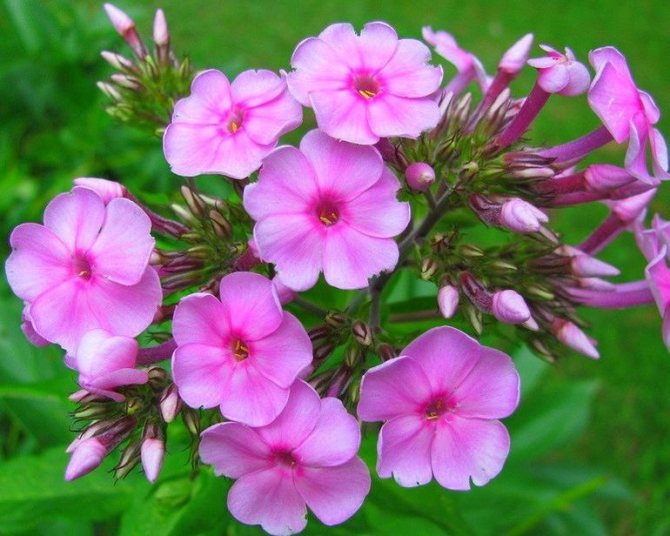

How to plant a night violet in a summer cottage?
Sowing of seeds is carried out somewhere in the beginning of April, when the possibility of germs is excluded. Also, for good and stable growth, it is best to follow some guidelines:
- Location. It is better to choose a place for landing that is sufficiently lit, but not in the open sun. It is good if there is a slight darkening nearby from a spreading tree or shrub. Avoid sowing near vegetable crops such as cabbage, tomatoes, and potatoes, as there is the potential for pests to move to the violet.
- The soil. The flower does not like too acidic soil, so it is best to remove the top layer and mix it with ash. It is also important to remember about the nutritional value of the soil by adding peat or humus.
- Humidity. The amount of moisture does not affect the growth of the plant in any way. The night violet easily tolerates drought, but this, nevertheless, can affect the appearance.
Collection and storage of medicinal raw materials
It does not matter where the two-leaved lyubka grows, it is forbidden to collect it in places of natural growth. Therefore, for industrial production, it is grown in special nurseries, which are organized on the bases of reserves.
But if you wish, you can grow it yourself on your site. The seeds of the plant are sold in the same nurseries or specialty stores.
Important! Lyubka two-leaved reproduces exclusively by seeds. When planting it on your site, do not expect the plant to appear soon. The seeds can germinate for several years after sowing.
The root of lyubka two-leaved is harvested when the plant blooms, in extreme cases, immediately after flowering. Only daughter, young fleshy tubers are suitable for blanks.
They are picked out of the ground, washed in running water, cleaned, and then dipped in boiling water for a couple of minutes.
After that, the workpieces are to be dried: in special cabinets or in dark, ventilated places. If a drying chamber is used, its temperature must be set at 50-60 ° C.
After drying, the tubers become horny and very hard. They must be folded in paper bags, folded in a container for storage and tightly closed. The container is placed in a dry place. If moisture gets into the tubers, they can become moldy.
Healing properties are also possessed by such plants as: nettle, thistle, quinoa, yarrow, chervil, dodder, purslane, foxglove, sedum, loosestrife, wild rosemary, swimsuit, buttercups.
How to care for a night violet?
As mentioned above, the night violet does not need complicated care, so everyone can grow it in their summer cottage. What does the care include?
- Watering. You need to water the flower no more than once a week. If it rained, then even less often. The main problem that may arise for owners of a night violet is severe waterlogging, which leads to decay of the root system.
- Weed control. Large weeds can dampen flower growth, so be careful to kill all weeds and loosen the soil in time.
- Spraying against pests. As for insects, the night violet is not strongly attacked by them, but it is still necessary to protect the plant. For this, you can use both chemical and folk remedies.
- Fertilizer. As a nutrition, mineral fertilizers for flowers, which can be purchased in all specialized stores, will be an excellent solution.
So, night violet flower, photo, planting and care behind which it is simple, will be an excellent decoration for your summer cottage, and also fill it with a wonderful, delicate aroma.
Night violet or scientifically hesperis refers to biennial plants. The flower has a pleasant aroma, which intensifies towards night, simple but spectacular flowers of a delicate pink, lilac color, as well as long flowering.
Exterior use
Several decades ago, mattiola was considered a fairly popular herb. It is less common these days. The plant looks great in the classic park direction. He is very fond of flower growers who prefer traditional styles. Blossoming brushes have an enchanting scent that fills the flower garden with a special charm.
Terry levkoi blend harmoniously with other summer flowers. The most interesting combinations are obtained with rosemary, decorative wormwood, lavender. Two-horned matthiols look good in tandem with pyrethrum and phlox. Ornamental deciduous plants and spicy herbs - thyme, thyme - emphasize the attractiveness of the night violet.
White, pale pink, purple levkoi are planted in the foreground of flower beds and flower beds, as well as along garden paths. Flowers are often used for landscaping and decorating loggias and balconies. They are also suitable for growing in flowerpots. Low-growing varieties are used to decorate ponds and pools.
High varieties of matthiola are suitable for creating floristic compositions. Plants do not lose their original appearance and pleasant smell throughout the week.
Mattiola is a night violet, beautiful and mysterious. The flower is unpretentious to care for, so it is often grown by novice gardeners. The plant opens up ample opportunities for creating original landscape design projects.
Diseases and pests
Night violet is not too susceptible to diseases and damage by pests. But still, not a single plant is immune from these situations. Therefore, it is better to study in advance the possible diseases that most often overtake noctresses. Root rot. This nuisance arises in the case of excessive soil moisture. The main symptom is leaf damage. As a treatment, you need to dry the soil as soon as possible and then carefully monitor the amount of watering. The affected leaves should be removed immediately. If timely measures are not taken, the plant will die.
Keela. This is a root disease that affects many crucifers. A plant with this disease begins to die. There is no cure. It is necessary to immediately burn the diseased plant, and treat the soil with special means and mix with lime. Cruciferous flea. This pest leaves behind small holes in the leaves. Defeating a flea is quite simple - just sprinkle the plants and soil with crushed wood ash.
Evening party of the matron night violet Planting and care Photo varieties Flower with a wonderful smell
What is the name of the night violet, not everyone knows. The name of the night violet is not only for the matron's nocturnal flower, it is also called mattiola, and even certain varieties of viola. We will focus our attention on the hesperis of the matron, according to the scientific Hesperis matronalis or night violet nocturnal, which has a unique aroma. After all, a garden can not only delight with a riot of colors, but also amaze with a refined smell.
Each flower, bush, tree has its own special aroma, which can be enhanced under the influence of favorable factors. Peonies beckon in sunny weather, closer to noon, roses give off an aroma in the evening, and the night violet beckons to itself after rain and closer to night. For harmony, the garden should have flowers with different periods of flowering and fragrance. So bees in the garden will be constantly, which means that fruit trees will be pollinated.
Growing night violets from seeds
Agricultural holdings for the production of seeds offer several options for the names of the night violet: Matrona's hesperis or Matrona's nocturnal. There are single color sets and color mixes. Some companies offer terry varieties. All of them are equally beautiful and unpretentious to care for.
How to plant a night violet with seeds in open ground:
- planting seeds directly into the ground from May to October (autumn sowing will sprout immediately after the snow melts);
- sowing depth 1-2 cm into moist soil;
- transplanting with great success, it is better to remove it from the ground with a small clod, without clearing the roots from the soil (this reduces the risk of overdrying the root system);
- It is better to leave the distance between the bushes at least 30 cm, or 35-40.
- flowering usually occurs in the second year of life, but with early planting of the first buds, you can wait until the end of summer;
- fruits, brown-brown pods, give offspring by self-seeding or specially organized sowing at any time.
- seed ripening ranges from late August to September.
How to plant a night violet with seeds for seedlings:
When to plant a night violet to get seedlings from seeds? Sowing dates - from the twenties of March to early April. The seeds are small, so most often growers sow them in boxes or containers, and then dive into separate cups. You can tinker a little and plant 1-2 seeds in a glass, so that later you do not engage in diving seedlings. Here everyone decides for himself what is more convenient.
- You need to prepare a nutritious soil with an abundance of organic matter or buy a ready-made soil mixture for flowers, fill containers.
- The seeding depth is 0.5-1 cm.
- The distance is as rare as possible, at least 2-3 cm between plants.
- When 2-3 true leaves appear, dense shoots dive into separate containers.
- Care consists in regular watering and providing good lighting, it is advisable not to put the plants in direct sunlight.
- When the seedlings reach a height of 8-10 cm, hardening begins: they take the containers outside, gradually increasing the duration of the air-sun baths.
- After two weeks of hardening, the plants are safely planted in open ground, the main thing is that there are no frosts at night.
Wells are prepared in advance, spilled with water. Then carefully remove the seedlings with a lump of earth and set them vertically in the hole, sprinkle with earth. Water abundantly. The distance between plants is 30-40 cm.
Growing seedlings
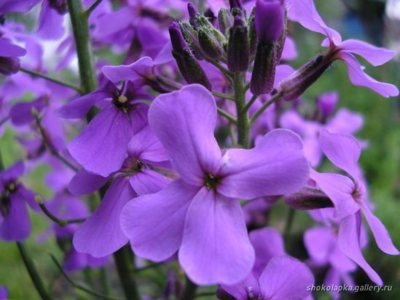

If you want to get seedlings faster, soak the seeds in plain water and stand for 24 hours. Then place them in a damp cloth, place them in the refrigerator. Stratification will strengthen the immunity of the future plant.
I grow night violets in seedlings. Seeds should be planted in mid-spring (around April 15th). I recommend using small drawers. Matthiola substrate can be made at home. Take 1 part sand and mix with 3 parts turf soil.
Spread the seeds on the surface of the substrate, embed them to a depth of 5 cm and put the film on top. Seedlings break through at a temperature of 22 degrees.After 5 days, sprouts will appear, then you will need to remove the covering material.
After 5 days after germination, water will need to be added. Wait another week and dive. Transplant your plants into separate pots. The mixture should consist of 1 part sand and 3 parts turf.
Seedlings will not form leaves, but this should not confuse you. To strengthen the immunity of the future plant, when transplanting, add 2 tbsp. l. hydrogel.
When the seedlings form two strong leaves, apply a complex fertilizer consisting of 1 g of sulfuric acid potassium, 3 g of copper sulfate and boric acid dissolved in 1100 ml of water (this amount is calculated per 1 sq. M).
I recommend keeping the hardened seedlings on the veranda. Remember that they must be tempered. At the beginning, open the window for 15 minutes, then for an hour or two. I advise you to harden the seedlings 15 days before planting in the ground. Planting and caring for matthiola is not difficult.
Reproduction of the matron's hesperis by cuttings and dividing the bush
Terry varieties are divided by cuttings or dividing the bush. The sprouts that have not had time to discard the peduncles are selected, carefully cut and rooted in seedling cups, planting them to a depth of 2-3 cm.You can create greenhouse conditions to accelerate root formation. Watering with root roots helps well.
It is very simple to divide the bush: carefully dig up the rhizome, divide it into 2-3 parts with a knife and plant the plants at the same level as before, trying not to overestimate the roots and not to bury it excessively.
Amazing lubka double-leaved
Two (rarely three) large leaves with arched venation. An almost leafless stem between them. Loose raceme of white flowers. Indeed, it is somewhat reminiscent of a lily of the valley. But only reminds.
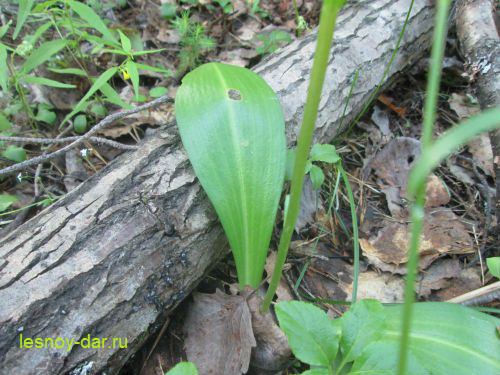

Flowers in Lyubka two-leaved, like in other orchids, are very peculiar. The perianth consists of two circles. It's actually three sepals and three petals. Only they are all white, slightly greenish.
One of the petals is greatly changed and represents an elongated lip. And its reverse side has turned into a long, slightly curved spur - a container of nectar.


Lip is a "landing site" for a pollinating insect. The spur is a bait for him. Everything is arranged so that the insect is comfortably accommodated and receives pollen as a “load”.
As you can see, the flower is completely different from the elegant white bells of a lily of the valley. And the two-leaved Lyubka blooms a little later - its time is June and early July.
Inflorescence is a loose raceme on a long peduncle with scaly leaves. After pollination, fruits are formed - capsules with many tiny seeds.
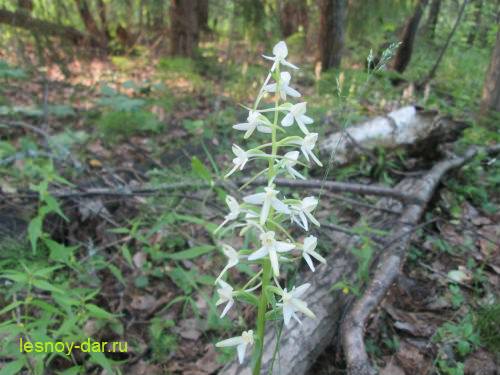

Seeds of lyubka bifolia (like other orchids) do not contain a supply of nutrients. Such a seed will germinate only if it encounters hyphae of soil fungi. Orchids can germinate only in symbiosis with mushrooms!
In the soil of Lyubka two-leaved there are two rather large root tubers, the size of a hazelnut. They are updated annually. A new tuber appears and grows, but at the same time the old one dries out.
So it turns out that Lyubka two-leaved reproduces only by seeds. And this method is not so reliable!
You can meet two-leaved Lyubka in a spruce-birch forest, in broad-leaved oak forests, in mixed forests. Grows in copses, in thickets of bushes. Always in the shade. Always on sufficiently fertile soil. In the forests of European countries, in the European part of Russia, in Western and Eastern Siberia.
There are also closely related species of the same genus - for example, green-flowered lyubka.
Biological description
Night violet is an unpretentious, modest flower that belongs to the cabbage family. The wild-growing species is widespread throughout the country. It grows mainly on the banks of water bodies, open forest glades, side parts of roads. Outwardly, the plant resembles paniculate phlox.
Plant height does not exceed 80 cm. Stems are erect with a branched upper part.Elongated lanceolate leaf plates are arranged alternately on the stem. The surface is slightly pubescent with a few villi. The size of the leaves increases towards the base of the stem.
Already in the second year of life, the plant blooms. From the first days of May, "Vechernitsa" decorates the flower garden. Under favorable weather conditions, the flowering period is extended until the beginning of autumn. Small flowers with a diameter of 1.5-2 cm consist of four oval petals and are symmetrically attached to a long peduncle. Loose inflorescences of medium size have a brush-like, less often spherical shape.
A variety of bright colors gives room for the imagination of flower growers and creates a riot of colors in the flower beds. The plant blooms with lilac, white or various shades of lilac flowers. Regardless of color, all flowers after dusk emit a subtle, heady aroma. At the end of flowering, the plant forms long, narrow pod fruits with small brown seeds in place of flowers.


Night flower violet methods of growing nocturnia, care, plant propagation
For a long time, plants that have a pleasant smell have been very popular among gardeners. These plants include the night violet flower. Its peculiarity is a fragrant smell, which is especially felt in the evening and at night. The flower is also called the matron's nocturnal. But they are related only by a pleasant aroma.
Night violet is also very similar in appearance to phlox, therefore it is also called "bovine phlox".
Belongs to the cruciferous family. It has oblong leaves, flowers are double or regular. Annual.
Growing a night violet
Night violets are cultivated as an annual plant. Its stems can grow up to 80 cm per season. Shoots, as a rule, are covered with narrow leaves. Depending on the variety, the plants are pubescent, smooth, silvery-gray or green. Terry varieties of night violets are especially attractive. Photo of this confirmation.
The cultivation of night violets (noctresses) requires constant care. Weeds around young shoots must be carefully weeded out.
The seeds of the plant are contained in its fruit. The fruit is a pod up to 6 centimeters long. The nocturnal seed remains viable for 3 years.
The nocturnal flower has several varieties.
The following varieties are most in demand:
Sowing is carried out directly into open ground, starting from early April to June. The distance between the rows of the matron must be at least 10 centimeters. The seeds are dipped into the soil by half a centimeter.
In greenhouse conditions, the seed can be sown in a pot, sprinkling with a layer of earth on top. The pot should be in a cool but lighted place. The sprouts will appear quickly, then they are planted in open ground.
Night violet grows best in an open, sunny place. This contributes to an increase in its decorative effect. A year after planting, a dense rosette of leaves appears. A long and highly branching stem will appear only in the second year after planting.
The nocturnal seed can be added to the flower mix. This will make the lawn even more attractive. You can clearly see what the night violet looks like in the photo.
Lighting
Vechernitsa loves to grow in open, lighted ground, but can feel great even in the shade of large trees.
Air humidity
Air humidity for violets does not matter. A slightly higher humidity will even contribute to the active growth of the plant.
Air temperature
The nocturnal flower is considered cold-resistant. Withstands temperatures up to minus 5 degrees C. Therefore, it often does not freeze even in winter. At high temperatures, the plant also feels great.
Top dressing
Vechornitsa is fed during flowering or active growth with complex mineral fertilizers. Lime is necessarily added to the soil. Granular fertilizers are scattered around the bushes and covered slightly with soil when it is loosened.
Transfer
The nocturnal tolerates the transplant perfectly. But replanting is required in pre-moistened soil. Even during the flowering period, the flower tolerates transplantation well.
Reproduction
Vectorals are propagated by seeds in late autumn or spring. The seed sprouts on day 10. After two months, the night violet begins to bloom. Before sowing, it is required to add drainage and fertilizers to the soil.
Vechernitsa seedlings must be thinned out. The terry species reproduces by dividing the bush. To extend the flowering period of the night violet, the already faded inflorescences should be removed.
Diseases of the night violet
The plant can be harmed by:
Night violets in landscape design
In the garden, a night violet flower is planted along the paths. Vechernitsa is an excellent decor for an artificial reservoir. The evening party is also irreplaceable for creating flower beds and flower beds.
The photo shows how you can arrange the evening party in the places that are reserved for relaxation. Night violet looks great in flower arrangements.
Application
Night violet is used as a remedy in folk medicine.
Decoctions are prepared from the plant for treatment:
Vectoral infusions are used as diaphoretic and diuretics. Helps the plant in the treatment of the respiratory tract.
Alcohol tincture from the leaves has an antibacterial effect, is indispensable for infectious diseases.
You can use nocturnal seed sprouts. They contain a lot of vitamins C and A, minerals iron, calcium, magnesium, phosphorus).
Night beauty violet
How Hesperis reproduces
Caring for and planting a plant is not difficult, the flower blooms profusely even with self-sowing in the field. Vechernitsa propagates in several ways: by seeds, seedlings and cuttings.
Advice. To prevent self-sown plants from filling the entire flower bed, plant young shoots every three years.
Seedlings and seeds
After the first frost, it is necessary to collect the pods of nocturnal Small oblong coffee-colored seeds ripen in them. Seeds are sown in the spring at the end of the warming up of the earth or in the autumn. When sowing in spring, the beds are covered with a polyethylene sheath, forming greenhouse conditions.


The plant is also fruitful by the seedling method. This will require a vessel with loose soil, fed with humus. The seeds are sown at the beginning of April, throwing five millimeters of soil into them. The ground is watered on top, and then covered with a film. The containers are stored in a room with an air temperature of 20 ° C. Seedlings emerge after 15–20 days. After the completion of the formation of 3 key leaves, the nocturnal is placed in a permanent place, with a distance of 25–30 cm from each other. During the habituation period, the plant badly needs watering. The formation of the root system will be promoted by air exchange, which guarantees loosening. It is necessary to weed out in time weeds that retard the growth of flowers.
Cuttings
Terry forms of hesperis do not propagate by seeds. It is required to divide the bush in August-September. For grafting, the lateral shoots are most often used, formed on the evening after flowering.
Common varieties of horned violets
Breeders are actively engaged in crossing and breeding new varieties of Viola cornuta. Many seed producers have divided hybrid forms into two groups:
- Cornuta - includes several series, among which Velor (10 colors), Princess (7 colors) are popular.
- Viola x hybrida - the plants have a complex hybrid origin, but the basis is Viola cornuta. The most famous variety series: Sorbet (20 shades), Penny (15 shades).
Lovers of perennial violets can choose one-color varieties (white, cream, blue), as well as two or three colors. When growing hybrids, it should be remembered that they tolerate frost worse. You should take care of the shelter for the winter. Some varieties are biennial.
Viola "Molly Sanderson"


The original coloring of the perennial will appeal to lovers of exotic.The flowers are black or purple with a yellow center. Bushes are low, up to 15 cm, spreading. The leaves are green, shiny. The variety is resistant to wintering, a light cover is enough. It is used for planting in rockeries, rock gardens, mixborders. The beginning of flowering is April. Prefers shaded areas.
Horned violet "Rebecca"
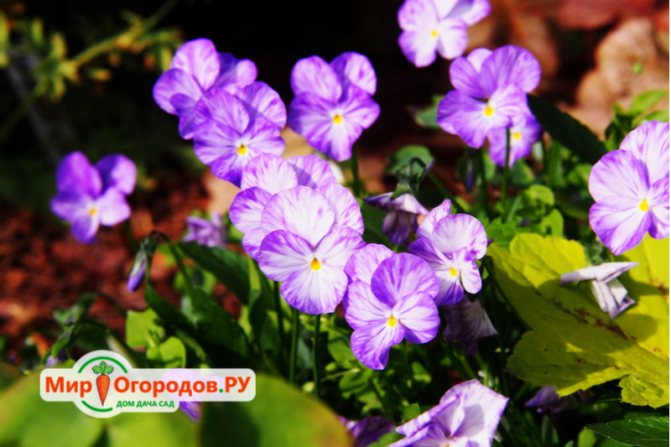

This variety is prized for its abundant and long-lasting flowering. It grows up to 15 cm. It is used for planting around coniferous and deciduous shrubs. When it grows, a lush rug is formed with many leaves and flowers. The color of the petals is light yellow with purple strokes along the edges. Bloom from June to the first frost. In the summer, it requires watering.
Viola "Foxbrook Cream"


A distinctive feature of the variety is the snow-white petals of violets. It is perfect for decorating the foreground of borders and flower beds. Perennial grows in partial shade and in open areas. Leaves are not cut for the winter. Bloom from May to September.
Variety "Boughton Blue" ("Boughton Blue")
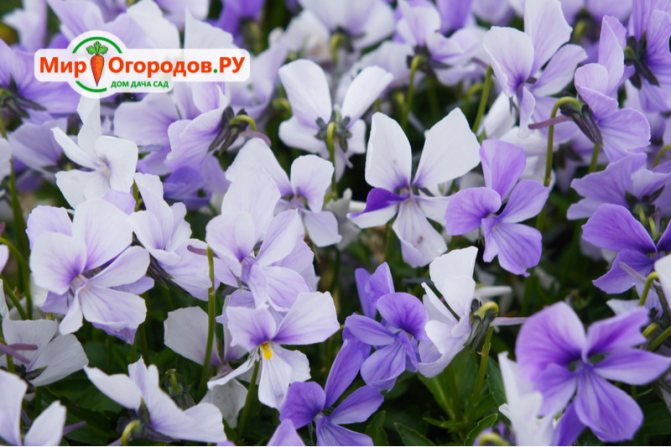

Bushes grow up to only 10 cm, but pale blue flowers delight with beauty from March to frost. An unpretentious perennial suitable for planting in pots. Prefers light, moist soil.
Violet Viola Columbine
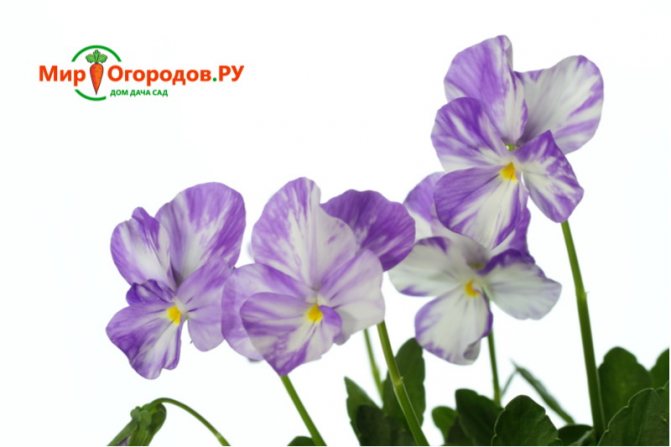

The stems of the creeping plant form turf up to 20 cm high. The leaves are green, oblong, with large teeth. Numerous flowers are variegated in color, their petals combine white, purple and blue. The plant needs loose, fertile soil. Flowering lasts from May to October. In winters with little snow, it is recommended to cover with spruce branches.
Types of nocturnal
Most cultivated varieties have simple flowers, but there are also double flowers. In gardens and parks, you can find several unpretentious, but fragrant and attractive plant species.
Violet matron's party
An ornamental plant that prefers loose soil. Blooms in the second year of life. Purple flowers are collected in large cylindrical brushes. They have a strong, persistent aroma. Flower diameter up to 2 cm. Can be grown by direct sowing in the soil in May-June.
Hesperis Romance
A popular decorative biennial with simple or double flowers in white. The plant is characterized by a persistent pleasant aroma exuding at night. It prefers light areas, but feels good in partial shade. Used for cutting and decorating group beds and paths.
Hesperis Inspiration
A branched biennial with simple flowers of lilac, purple or white, collected in a brush. Prefers slightly alkaline soils. The plant is suitable for planting in a mixborder, rabatka. Height 80-90 cm. Abundant fragrant inflorescences will decorate any bouquet. Differs in frost resistance.
Matron's party crimson
An unpretentious flower known as the night violet. Branched erect stems are decorated with many crimson flowers. At night and in the evening, the biennial spreads a pleasant fragrance. Blooms from May to July. Looks great as a background plant for landscaped gardens. Seedlings are planted in June at a distance of 30 cm from each other. It can multiply by self-seeding.
Vechernitsa night beauty
One of the most fragrant varieties of hesperis blooms in the second year after planting. Its flowers are delicate lilac hue collected in beautiful large brushes. The plant is resistant to frost and disease. It grows to a height of 50-75 cm. The flower is suitable for cutting, used in group and single plantings. Can be grown on the balcony.
Description: A wealthy official has a beautiful kept mistress. Once upon a time, an official pulled the girl Rita out of an underground brothel. The young woman is indeed very beautiful and it is not very clear how she even became involved in prostitution. The beauty fell in love with the high rank, and he began to present her with solid gifts. Over time, Rita got a car, an apartment, money and luxurious gifts.The enamored representative of the authorities demanded in return for only one thing, that Rita was faithful only to him and did not even try to flirt on the side.
At first, the main character followed completely and completely the basic requirement of her sponsor. This lasted until Rita met the man of her life. She just fell in love with a common man. Quite by chance, she met Alexei, a student at Moscow State University. Although he does not have a lot of money, the girl really liked him. He has charm, beauty, an inquisitive mind and a fairly wealthy family. In addition, Alexei has a successful career.
A young student falls in love with Rita at first sight, he absolutely does not care who she was in the past and who she is now. The only thing he wants now is to marry Rita and live a happy life
However, Rita's lover soon learns about Alexei. In a rage, he takes all of Rita's property, presented to him. He takes away all the gifts, the apartment, the car and drives them out into the street. Alexei invites the girl to settle in his dacha. Here in the Moscow region, they plan to spend the whole summer, and then Alexey will find a job, and they will move to the city, where they will rent an apartment.
Unexpected news destroys the quiet life of a couple in love. Alexei's parents learned from somewhere that Rita had been a prostitute in the past. During Alexei's departure from home, his father comes to visit Rita. An intelligent dad asks the girl for one thing, so that she leave his son alone and go where far away. According to her father, she will ruin Alexei's whole life.
The conversation with Alexei's father greatly hurt Rita. Late in the evening, when Alexei returned home, she told him that she no longer loved him and that she was returning to her influential lover. This behavior of his beloved girl shocked Alexei to the depths of his soul. In his hearts, he shouted to her to get away. Rita, silently packing up her things, left the house without saying a word about the conversation with her father and about her old illness.
Only a year later, Alexei's hero learns the whole truth. He still loves Rita and hopes that things will come to their senses. Will the protagonist be able to return his love, will show the TV series Night Violet watch online in good quality. The premiere of the mini-series will take place on the Ukrainian TV channel Inter on June 2. Don't miss the first episodes of the same day on our portal. Happy viewing!
Plant characteristic
Flowers of mattiola bicorn are grown in an annual planting. The plant is quite unusual and has many differences. Its features:
- Matthiola has a straight or spreading stem, it depends on the variety. There are many shoots on the flower, they, like the foliage, have a dense fluff;
- the flower is quite tall, with proper care it can grow up to 60 centimeters;
- large teeth are clearly visible on bright green leaves;
- the plant has inflorescences in the form of brushes, they do not differ in the brightness of the color range. In addition, the flowers are very small;
- in the daytime the flower "sleeps", flowers bloom in the evening, spreading a pleasant smell;
- Mattiola blooms for a long time. If you plant flowers early, then flowering continues from the beginning of summer until the first frost;
- small seeds ripen in pods. The seeds retain their germination capacity for up to 3 years.
Varieties of matthiola
In nature, there are more than 50 varieties of matthiola. The people call the plant a fragrant violet. Most often, gardeners plant only two varieties on their site: Mattiola two-horned and Mattiola gray, it is also called levkoy. Breeders have developed many varieties of matthiola, which differ in color and aroma.
Landing


Blooms better, intense smell in sunny places. There are also disadvantages - during extreme heat, the flowers wither, not having time to open. In partial shade, mattiola stretches and blooms worse.
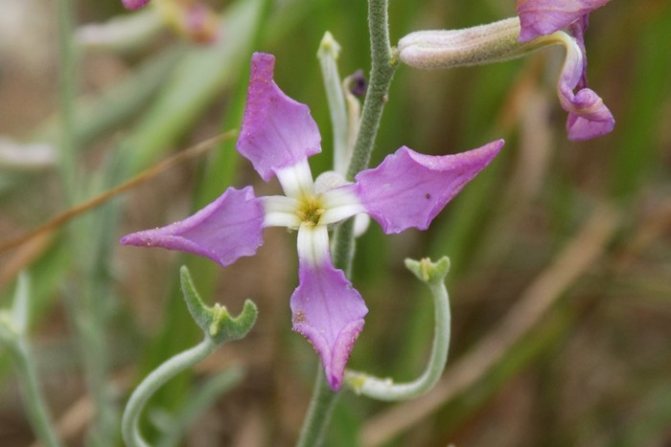

Matthiola two-horned will grow almost everywhere, and likes permeable, medium-fertile soils with a neutral pH. Do not plant on rich soils - it will grow strongly and bloom poorly.
It is better to sow on beds and flower beds by the nesting method. Several seeds are introduced into a shallow hole. The pits are no wider than 10 cm apart. You will get a compact bunch, thin stems adjacent to each other will retain their vertical shape. During watering, care must be taken that the water jet does not incline the plants to the ground.
When grown in containers, matthiola is sown thicker. By adding a lot of gravel to the ground. Top dressing is carried out once a week, with a more diluted fertilizer. Excess nitrogen leads to a loss of flower aroma. Given the small amount of land in the container, watering is carried out regularly, the land must not be allowed to completely dry out. For pot cultivation, you can install a metal hoop that is adapted to the size of the flowerpot and hammered into the ground with a pin. The hoop will prevent the matthiola from bending.
Varieties
- ‘Evening scent’ - strong-smelling lilac flowers, height up to 45 cm;
- ‘Lilak’ - light purple flowers, large toothed leaves, height up to 50 cm;
- ‘Summer evening’ - fragrant flowers, drought-resistant and frost-resistant variety, up to 50 cm high;
- ‘Starlight’ - pink, height up to 30 cm;
- ‘Lilac-pink’ - lilac-pink, height up to 40 cm. Looks great on Moorish lawns;
- ‘Night violet’ - rich lilac color with a white center, grows up to 20-25 cm;
- 'Vorozheya' - small lilac flowers with a wonderful aroma, used in groups near gazebos, verandas;
- 'Evening lights' - pale lilac-pink color, height 40cm, suitable for mixed disembarkation.
Mattiola two-horned varieties
There are different varieties. Let's dwell on a few of them.
Mattiola flower "evening fragrance" is an annual plant that does not require special care. The height of the stems reaches fifty centimeters. Differs in abundant flowering. Small lilac flowers open and fragrant in the evening, emitting a strong, pleasant aroma. The plant is light-loving. Tolerates light partial shade.
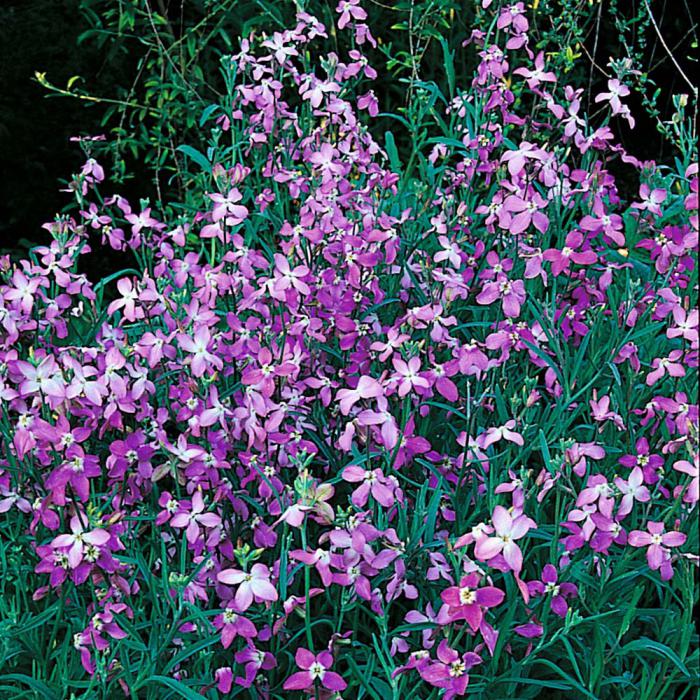

Mattiola "starlight" is an annual plant whose stems grow up to forty or fifty centimeters. Flowers of this variety, similar to all varieties of Mattiola bicorn, do not differ in their decorative appearance. They are small and inconspicuous, white or yellow. Blossom in the evening. They have a strong fragrant aroma.
Scented Favorite of the Night
The flower Mattiola two-horned, or night violet, is notable for the fact that it blooms in the evening. The coolness of the night is filled with the fragrant aroma of nondescript flowers.
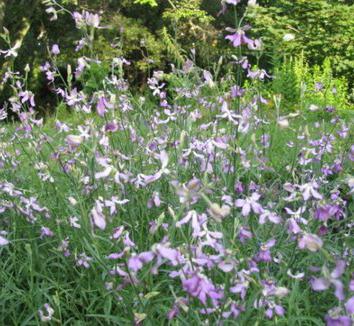

An upright annual plant with a strongly branching stem and small leaves. The root system is pivotal. Small, inconspicuous flowers with four petals form a racemose inflorescence with a strong pleasant smell. They are painted in pale lilac, white or light yellow. Night violets are flowers that open in the evening and remain so throughout the night. With the first rays of the sun, they close. The flowering period occurs in the first half of the summer period.
The fruits of the plant are small seed pods. They are filled with small seeds, which germinate for three years.
The use of Levkoy in garden decoration
Matthiola is not grown to create incredible flower arrangements, but to enjoy the amazing scent of the plant.


Therefore, it is planted in recreation areas - next to gazebos, barbecue areas, walking paths, alleys, under the windows of the house. This will allow you to enjoy the sophisticated notes of the Mediterranean aroma in the evening. Also, beautiful bouquets are formed from flowers that will stand in a vase for a very long time.
Sowing and picking
Even a novice florist who does not have sufficient experience with perennial and biennial plants can cope with the cultivation of matthiola. To get healthy and strong flower seedlings, sowing seeds should be carried out in May according to the following scheme:
- Small furrows must be made in the ground;
- The seeds are sown not too heap and shallow;
- Then you need to spray the soil (not watering) so that the seeds are not washed out;
- The beds are covered with foil, thereby creating greenhouse conditions for future seedlings;
- Periodically, the film must be removed so that the soil is ventilated.
You can sow seeds of mattiola both directly into the ground and into bowls (carried out according to the same scheme). When weeds appear between shoots, they must be removed in time so that the seedlings are not stunted. With a sufficiently warmed soil, the grower can wait for the sprouts to appear within a month after sowing the seeds in the ground. After that, you need to loosen the soil and moderate watering.


For seedlings on which 3 true leaves have already formed, a pick is used. It is enough just to thin out the seedlings so that the diameter of the free space near each sprout reaches about 30 cm. After the pick, it is recommended to water the plants abundantly and shade them from the sun's rays.
Application
A beautiful, fragrant nocturnal is widely used by landscape designers and amateur flower growers. In addition, it has unique healing properties, therefore it has found its application in folk and official medicine.
Landscape use
Designers actively use Matrona's evening party for landscaping. The unpretentiousness and long flowering period make these flowers a desirable acquisition not only for private plots, but also for city squares.
Beds with fragrant flowers are placed near gazebos, verandas, garden paths. This allows you to enjoy not only the humble beauty, but also the sweet floral scent.
The night violet looks especially beautiful in group plantings, forming bright spots on the ridges, alpine slides or on flower beds. The discreet beauty of flowers looks good with various types of summer flowers and with spicy herbs. The combination with the following plants looks spectacular:
- petunia;
- chamomile;
- marigold;
- lavender;
- nivyanik;
- fern.
Single plants refresh meadow and Moorish lawns well. Long, slender stems are great for cutting into wild bouquets. Cut flowers stay fresh for up to 1.5 weeks.


Medical use
Almost all parts of the plant have healing properties - stems, leaves, flowers, seeds. The plant is richest in essential oils, flavonoids, saponins, vitamins A, C, as well as microelements:
- phosphorus;
- magnesium;
- potassium;
- iron.
Decoctions from the leaves are used as a natural diaphoretic. Raw and dried flowers contain a large amount of vitamin C. Therefore, flower decoctions are a good vitamin remedy. Sprouted seeds improve appetite, restore body resources, and fight flatulence.
Planting
How to grow viola flowers from seed for seedlings
Not all Matthiola varieties can be propagated by dividing the bush, but terry plant varieties can easily tolerate this. The main method is to plant seeds in the soil. You can pre-sow the seeds in pots for seedlings - this should be done in the first days of spring. Since nocturnal seeds are highly germinating, it is recommended to plant them immediately in prepared soil.
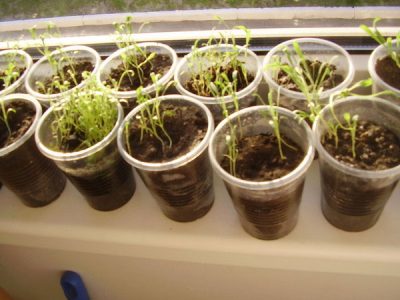

A suitable period for sowing seeds into the soil is the end of spring - early summer, when it is still cool. Very small seeds must be mixed with sand and sown in the designated place to a depth of one centimeter, evenly distributing and not creating a lot of crowding. A good option for sowing flower seeds on the site is planting in individual bowls. This will facilitate further weed control.
When the planting of seeds in the ground is finished, good moistening by spraying is necessary. Watering is not recommended - this can lead to soil erosion and loss of seeds. Pull a protective film on moist soil with a sown area.In the future, to provide fresh air access, it will need to be regularly removed or lifted.
To grow Matthiola rosea seedlings in small containers, you must first prepare them. Take some of the soil and sprinkle it on the bottom of the flower pot, then sow the seeds evenly. Lay a layer on top that contains peat and humus, 0.5 cm thick. Then you need to compact the soil composition a little, then sprinkle with water. The moisture should not be too strong. After watering, place the containers under glass or cover with a film that is capable of transmitting light.
Place containers with seedlings in a warm room, maintaining the air temperature at 20 degrees, and water regularly. The first shoots will begin to appear around the fifteenth day. A month later, you can expect the appearance of the first three leaves that have formed, after which you need to start diving seedlings. Then you need to water them abundantly with water and protect the plant sprouts from the sun's rays. If the nocturnal sprouts have sprouted very closely, then they need to be thinned. Each sprout requires space for itself with a diameter of 30 cm or more.
Matiola pink (night violet): photo, cultivation, planting and care
How to grow seedlings correctly
Usually the flower is not bred with seedlings, it is better to grow matthiola from seeds. The flower has weak roots, it does not tolerate transplanting well. However, if the gardener wants to get great aromas already at the beginning of summer, then it is better to use a seedling technique.
Before sowing seeds, you need to prepare containers and soil. The soil is used nutritious, loose, with excellent water and air permeability. Containers and soil must be treated with potassium permanganate.
Planting rules for matthiola:
- The seeds are sown in early February. Another sowing is carried out in March, then mattiola will bloom at different times.
- Since the seeds are quite small, they are scattered over the prepared soil, keeping a distance of at least 4 cm, and sprinkled with earth a little. You don't need to deepen the seeds. Carefully pour over them with warm water, cover with glass or foil.
- You need to place containers in the sun. Before the first shoots appear, it is better not to water.
To grow seedlings from seeds, special conditions are required. When the first shoots appear, it is necessary to create excellent lighting and reduce the temperature to + 12 ° C, otherwise the seedlings will stretch upwards.
If the seedlings are grown in boxes, then they need to be dived every 2 weeks. Keep in mind that with all care, some of the seedlings will die.
To minimize the risk of root damage, the soil must be well shed before planting. Each plant is carefully taken out, trying not to injure the delicate roots. In the container where we will transplant the plant, we make a hole, put the seedling and cover it with earth until the cotyledon leaves. So that the seedling can immediately contact the ground, we squeeze the soil around a little. After that, the plant must be watered.
Professional florists who have been growing matthiola for several years grow seedlings without diving. A box of eggs or chocolates is perfect for this. After filling the cells with soil, plant 2-3 seeds in a separate hole. As the seedlings grow, they leave one sprout, the strongest.
They plant a flower in a permanent place without destroying a lump of soil as soon as the warm time of the day comes. This is most often done in late spring - early summer. The planting is carried out, observing a distance of 15-30 centimeters, it all depends on the variety. In order for the plant to take root faster, it must be shaded.
Conditions for sowing seeds directly to the garden:
- The earth is spilled with potassium permanganate, loosened and grooves are formed with a depth of no more than 0.5 cm, otherwise the sprouts may not break through to the surface.
- For even distribution of seeds, they are mixed with sand in equal proportions and scattered into the furrows.
- Fall asleep with earth 0.5 cm.Do not tamp, you just need to sprinkle the soil with water a little.
Night violet, which is sown in autumn or spring, emerges in late May - early June.
How to choose a landing site
So that the plant grows healthy, does not stretch in height, it is planted in an area where there is enough sunlight. When disembarking, matthiola must be protected from the wind. Observing these conditions, you can be sure that the plant will grow in a short time, give brushes and delight you with a wonderful smell.
If we talk about the earth, then it should be loose and fertile... However, it is not recommended to fertilize the plant with manure, since it may contain phytophthora spores. The plant grows well on loamy and sandy loam soil... The acidity of the soil should be neutral.
It is not advised to plant a night violet in a place where representatives of cruciferous plants grew before. This can provoke a plant disease with keel or fungus.
The soil must be prepared in the fall. Digging makes it possible to prevent fungus or black leg. The earth needs to be dug at least 40 centimeters deep. You can dig up while adding manure to the soil.
How to properly care for seedlings
Mattiola two-horned will grow up healthy even among amateurs, if you follow all the rules of planting and caring for her.
Description


Natural habitat of Matthiola bicorn, northern Africa and southern Europe. Height, about 45 cm. Flowering periodif sowed in several passes, the flowers will be from mid-June until frost. Flower color, more often a lilac color with a purple tint, although it happens white.



